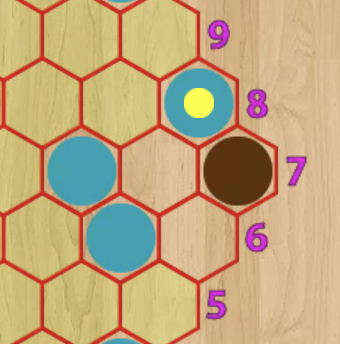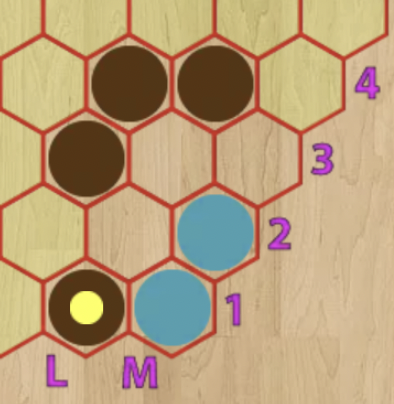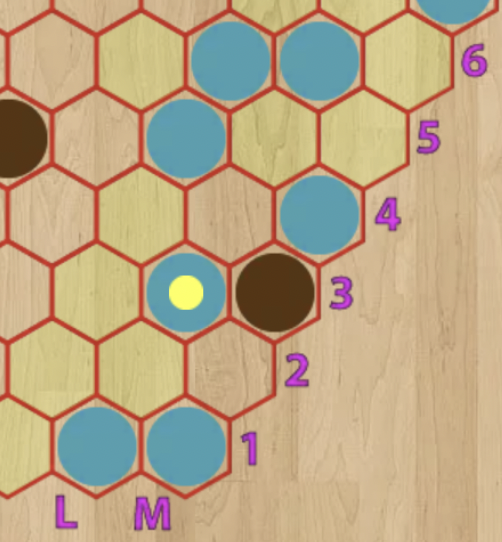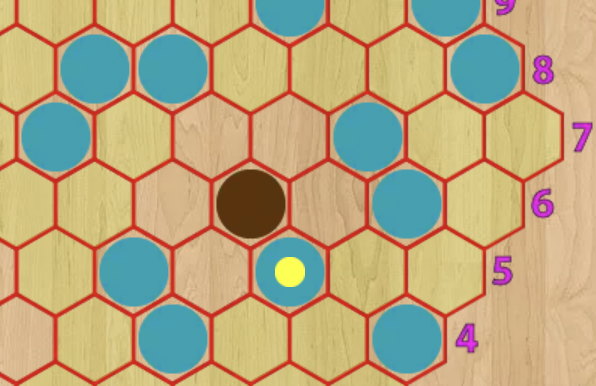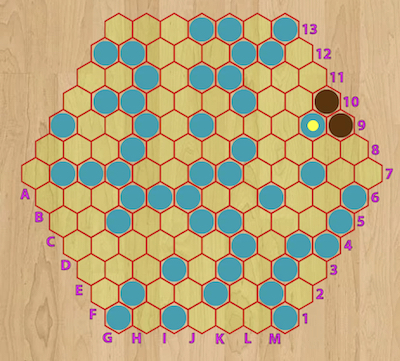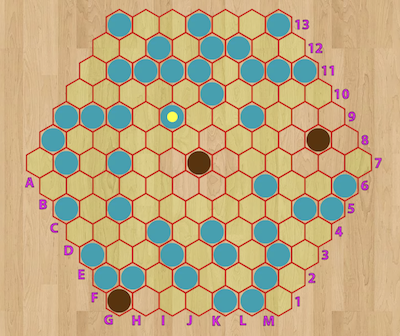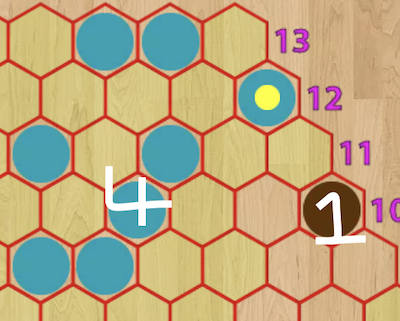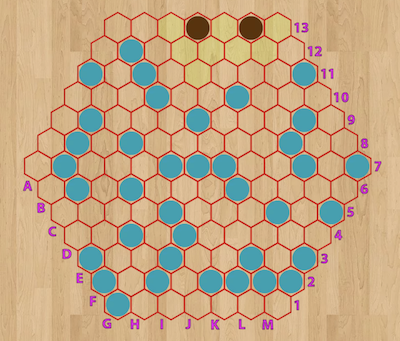This is a documentation for Board Game Arena: play board games online !
Tips oust: Difference between revisions
(Expand the tactics section with many more examples.) |
(Adding a section on having too many groups) |
||
| Line 10: | Line 10: | ||
* Allowing your opponent to have too large a group can lose you the game. It can be difficult, if not impossible to capture a group of about 20 stones on size 7 for instance. | * Allowing your opponent to have too large a group can lose you the game. It can be difficult, if not impossible to capture a group of about 20 stones on size 7 for instance. | ||
* Having only small groups next to opponents larger groups can put you at a large disadvantage. | * Having only small groups next to opponents larger groups can put you at a large disadvantage. | ||
* Look out for the N+2 rule in order to take advantage of tactics, i.e. if you have a group two sizes larger than the opponents nearby groups, there may be some tactics to take advantage of. See below for examples of tactics (trapping, lead in captures, attachments). | * Look out for the '''N+2''' rule in order to take advantage of tactics, i.e. if you have a group two sizes larger than the opponents nearby groups, there may be some tactics to take advantage of. See below for examples of tactics (trapping, lead in captures, attachments). | ||
* Some shapes are more efficient to merge groups later, but can be vulnerable to chain capturing. Be aware of this tradeoff! | * Some shapes are more efficient to merge groups later, but can be vulnerable to chain capturing. Be aware of this tradeoff! | ||
| Line 73: | Line 73: | ||
[[File:Oust_lead_in2.png]] | [[File:Oust_lead_in2.png]] | ||
== N+2 Rule == | |||
Now that some examples of tactics have been looked at, for capturing groups or generating free moves, and forcing the opponent to make another move, we can consider when is it likely for tactics to arise in a game? | |||
User manaT coined the term "N+2 rule" for Oust as a kind of heuristic on when to expect and look for tactics in Oust. Except in some special cases like the trapping tactics shown above, typically one wants to have a friendly group that is two sizes larger than neighbouring enemy groups, in order for some of the tactical ideas above to work. That is one might want a friendly size 3 or larger group near size 1 (singleton) enemy groups, size 4 beside enemy size 2 groups or smaller and so on. | |||
In the previous sections, one could see lead in captures and follow-up captures working when surrounding groups were at least two sizes larger, or much larger than the enemy group. Here are some more examples of buying time with placements and attachments, forcing the opponent to play another move, using the N+2 heuristic: | |||
[[File:Nplus2_1.png]] | |||
In the above, blue has a size 4 group and so can play the lead in capture move against the size 1 group. Below, Blue has two nearby size 3 groups, and so can play the attachment to the size 1 group, threatening a follow-up capture. | |||
[[File:Nplus2_2.png]] | |||
== Too many groups can lose == | |||
This isn't a heuristic that always applies, as can be seen in some of the previous sections and equally you by definition have to have more groups than the opponent when you win. However what it should do is caution you to time your captures, and control when you make them, and how many more groups you create than the opponent. | |||
For example, below, here's a position where the game should be completely lost for blue with good play from brown. Blue got into this position by capturing at almost every opportunity and didn't create many chances for tactics, or to force their opponent to play enough bad moves. | |||
[[File:Oust_too_many_groups.png]] | |||
The reason this position is losing for blue may not be completely obvious, but essentially, blue has run out of free moves, and their groups are very scattered and overall not very large (largest is size 6). Blue has no choice but to play either an attachment or at E11, which will allow brown either to start chain captures or to slowly grow and join their singletons into a larger and larger group, eventually recapturing all of blue's groups. Brown is now in control of the flow of the rest of the game. | |||
Revision as of 19:44, 24 June 2023
Overview
Oust can be a tricky game to get used to at first. The goal is to capture all your opponent's pieces, but initially there's no clear way to do this, since you can't capture or grow your own groups without your opponent's help in a sense.
Here's a brief overview of some strategic ideas and then if you wish you can read further in a dedicated section below:
- Try to place your stones in a way that gives you more free moves than your opponent. A free move is a move that either can't be captured by your opponent, or if captured gives them little to no gain in the game.
- Restrict the opponent's available moves. You don't always have to capture every stone and group of your opponent right away. If your group is strictly larger than a nearby group it could capture 2 beside 1, 3 beside 2 or 1 and so on, then you may be able to safely leave the opponent's dead stones on the board until later.
- You can sacrifice some stones in the beginning of the game to make the opponent's stones inefficient, that is they don't use the space around them effectively.
- Having too many more groups than your opponent can lose you the game.
- Allowing your opponent to have too large a group can lose you the game. It can be difficult, if not impossible to capture a group of about 20 stones on size 7 for instance.
- Having only small groups next to opponents larger groups can put you at a large disadvantage.
- Look out for the N+2 rule in order to take advantage of tactics, i.e. if you have a group two sizes larger than the opponents nearby groups, there may be some tactics to take advantage of. See below for examples of tactics (trapping, lead in captures, attachments).
- Some shapes are more efficient to merge groups later, but can be vulnerable to chain capturing. Be aware of this tradeoff!
Further sections detailing the above to be created and updated soon.
Tactics
This section will try to give examples of short term tactics in Oust, such as chain captures, lead-in captures, trapping and attachments.
Attachments
Typically when you play directly beside an opponents stone or group, attaching/touching to that stone or group, you immediately make it stronger. Usually the opponent can choose a direction to grow their group after the attachment. This will likely become unavoidable at some stages of the game. However there are some cases where attaching has its advantages:
Trapping
The tactic of trapping, is a particular type of attachment move, taking advantage of the rule for capturing placements, whereby you need to be larger than the opponents group you touch in order to capture it. We can think of this as an example of a free move mentioned above. Typically with these trapping moves you attach a single stone to your opponents single stone or group, in a situation where the opponent can only grow in directions where they would touch a group of the same size or larger. In these cases the opponent can't capture and it's like the group is trapped with no legal growing/capturing placements. The following images show some examples of trapping moves:
1) The easiest place to trap an opponents group is typically in corners, since there is already a limited number of directions to grow with capturing placements. Here a two stone group and an attachment traps the single brown stone.
2) An example of a three stone group and an attachment trapping two blue stones in the corner.
3) Trapping a single brown stone on the side of the board. It could only potentially grow in directions that touched two and three stone groups meaning it was trapped by the attachment.
4) Here the single brown stone could only grow into size two and three groups after the attachment, and so was trapped by the attachment, this time in the centre of the board.
Follow-up capture
Another way to use an attachment, is to create a kind of follow-up capture threat. This could either be to directly join the attachment stone back to a larger group which causes a capture, and in some cases this can potentially bring out of range groups in range of captures. Some examples of this type of follow-up capture are given below.
In the example above, blue has attached to the two brown stones, and is threatening to join back to their nearby single stone, creating a group of size 3, which will capture the two brown stones. This case is also similar to the lead-in capture (see section below) where brown has no safe direction to capture this stone without running too close to a larger group.
In the second example above, which comes from the trapping example 3, with this attachment, blue is also threatening follow-up captures. Without this attachment blue could only play at the X to capture the single stone. However after this attachment, blue can instead play the sequence 1,2,3,4 to capture all the brown groups adjacent, which is an example of chain-capturing (see next section).
Chain Captures
When making a capturing placement in Oust you must take another move. This can sometimes be a good thing and other times a bad thing, depending on whether you want to be the player making a move. However it does lead to the technique of chain captures, that is, multiple captures in a row in a single turn, which can be useful throughout the game and especially with good choice of timing. A simple example of chain capturing is show below.
Brown has attached to a Blue piece, and this has opened up two paths for Blue to chain capture the Brown groups. Blue can choose to go Northeast and then East twice to capture three groups including the side two group, or they can choose to go Northeast three times and capture the three singleton groups shown.
Lead in Captures
This is another way to play free moves, and a way to either delay playing detrimental moves yourself, or potentially a way to capture stones and possibly end games. The move below is an example of a lead-in capture. Blue plays a single stone in capturing range of the brown stone. However if Brown captures at the X spot, then they move in capturing range of the larger size 3 blue group, and so they have been led into a capture by a capture. If Brown doesn't capture they can be captured next by Blue. This can be a useful way to force the opponent to decide to give up on stones or be forced to capture stones.
In the above case Brown could capture eastward and avoid a recapture, however in special cases that might not be an option like in the example below, Brown has no good options after the lead in capture move shown.
N+2 Rule
Now that some examples of tactics have been looked at, for capturing groups or generating free moves, and forcing the opponent to make another move, we can consider when is it likely for tactics to arise in a game?
User manaT coined the term "N+2 rule" for Oust as a kind of heuristic on when to expect and look for tactics in Oust. Except in some special cases like the trapping tactics shown above, typically one wants to have a friendly group that is two sizes larger than neighbouring enemy groups, in order for some of the tactical ideas above to work. That is one might want a friendly size 3 or larger group near size 1 (singleton) enemy groups, size 4 beside enemy size 2 groups or smaller and so on.
In the previous sections, one could see lead in captures and follow-up captures working when surrounding groups were at least two sizes larger, or much larger than the enemy group. Here are some more examples of buying time with placements and attachments, forcing the opponent to play another move, using the N+2 heuristic:
In the above, blue has a size 4 group and so can play the lead in capture move against the size 1 group. Below, Blue has two nearby size 3 groups, and so can play the attachment to the size 1 group, threatening a follow-up capture.
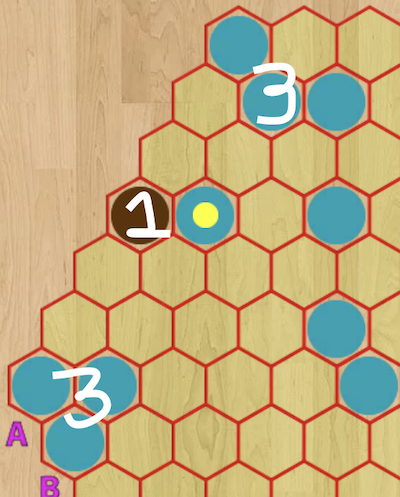
Too many groups can lose
This isn't a heuristic that always applies, as can be seen in some of the previous sections and equally you by definition have to have more groups than the opponent when you win. However what it should do is caution you to time your captures, and control when you make them, and how many more groups you create than the opponent.
For example, below, here's a position where the game should be completely lost for blue with good play from brown. Blue got into this position by capturing at almost every opportunity and didn't create many chances for tactics, or to force their opponent to play enough bad moves.
The reason this position is losing for blue may not be completely obvious, but essentially, blue has run out of free moves, and their groups are very scattered and overall not very large (largest is size 6). Blue has no choice but to play either an attachment or at E11, which will allow brown either to start chain captures or to slowly grow and join their singletons into a larger and larger group, eventually recapturing all of blue's groups. Brown is now in control of the flow of the rest of the game.
